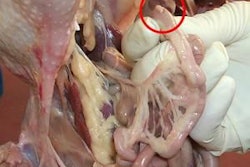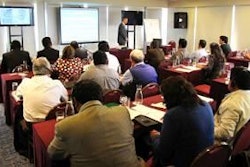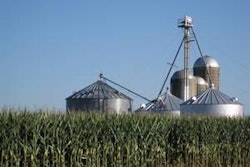
Are feed mills and grain handling facilities likely to be a major terrorist threat? “Probably not,” says Dr. Leland McKinney, extension state leader, Department of Grain Science and Industry, Kansas State University.
McKinney does advise companies to take “common sense precautions,” such as completing employee background checks and limiting access to company sites.
Bio-terrorism safeguards
A Kansas State University study of feed mills and ethanol plants, concluded that many “have very little protection” against agroterrorism.
Faced with federal directives the industry has taken action to reduce the probability of deliberate intrusion and harm. McKinney comments “it used to be that anybody could walk into a plant. Now you have to check in.” In addition, he says, “most plants have good quality control procedures.” He continues that there are ways the industry could be made safer, such as having guarded entrances and video surveillance. The reality is that precautions must be practical and harmonized with work flow to be effective.
New biosecurity threats
But just because the feed industry is less likely than other industries to be a target for bioterrorism, it does not mean that plant management should be casual or negligent in protecting assets and products.
“The likelihood of terrorist acts interrupting the manufacture, processing, and distribution of agricultural products is high,” maintains McKinney. A number of disruptive acts or introduction of pathogens could cause harm or loss of production. Even the suspicion of an act could impact a brand, consumer rejection of commodities or generate fear.
According to the American Feed Industry Association, processed ingredients, livestock and pet food serve as potential vehicles for intentional contamination, resulting in both direct and indirect damage. The “time is right” for promoting biosecurity for the feed industry, AFIA concludes.
Creating a HAACP plan
Today the biggest biosecurity threats to the feed industry most probably come from within an operation. An action by a determined disgruntled employee is difficult to prevent McKinney says. Ensuring the vigilance of all workers, supervisors and management and restricting opportunities for willful acts should be established practices in plants.
McKinney adds that most incidents that occur today are accidental, although he notes that the recent melamine contamination “was indirectly intentional.”
One way to reduce the chance that feed could become contaminated, McKinney comments, is through the use of a Hazard Analysis Critical Control Point (HACCP) plan.
According to McKinney, it’s important for feed mills to protect against mycotoxins and bacterial pathogens. Foreign compounds can be introduced into plants and be incorporated in feeds which enter the food chain. Documented examples include dioxins and PCB contamination which usually have complicated routes of access to consumers.
Reducing the risk
Procedures have been established for feed plants to reduce the risk of contamination. Meat and bone meal should not be present in plants compounding ruminant feed because of the risk of BSE.
Special precautions and good management practices dictate securing of feed additive drugs and establishing procedures for their use in accordance with statutory label instructions. Standard operating procedures such as flushing are required to prevent carry-over into non-medicated diets.
Control visitors
Authorized visitors to a feed plant should be registered and follow procedures which contribute to biosecurity. These include verifying credentials and being escorted by a designated company representative. This reduces unwanted visitors, protects proprietary information and will account for all persons in the event of an emergency.


















